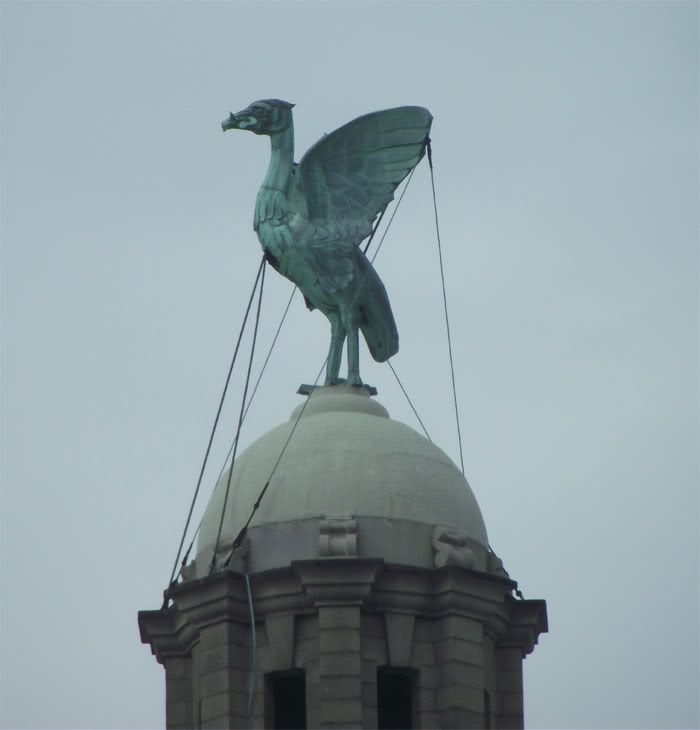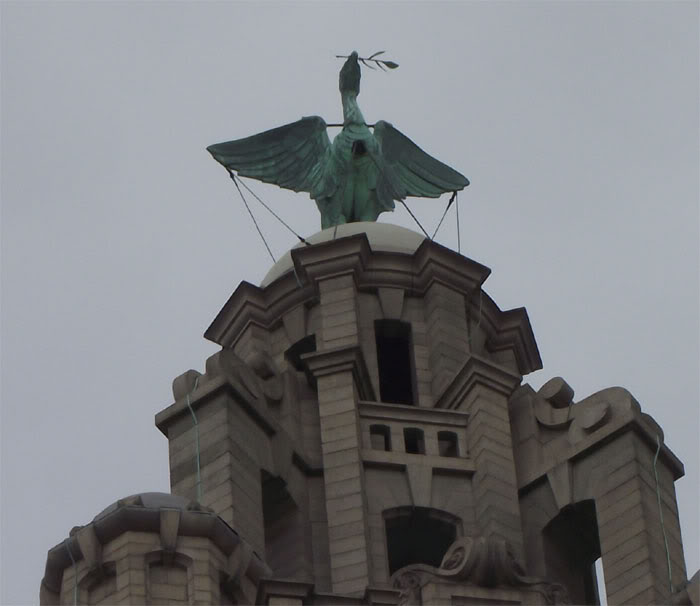
Ode to the Liver
Writers on the etymology of the word Liverpool are accustomed to reject the tradition of the existence of a species of bird denominated the Liver, as entirely fabulous. For this there is no sufficient reason. Livia was undoubtedly the Latin denomination of a wild bird, whether a wood-pigeon or a water fowl, is extremely doubtful for the short description of it in Pliny. It is worthy of remark that Liviopolis the name of a town situated on the shores of the Euzine, the coast of which abounded with the bird Livia, and which name is generally derived from the Empress Livia, bears great similarity to the word Liverpool. From the constant interchange of the letters b and v in the Greek and Latin languages, I have ventured to suppose the root of the word Liver to have been the same as that of Liber, free, and I have therefore styled the Liver the bird of Freedom.
ODE
O, Bird of Freedom, that of yore,
Built thy lone nest on Mersey's shore,
Fond of the stoney bed; -
Till there the steps of man were heard,
And sails upon the stream appear'd, -
Thy pinions then, outspread,
Bore thee upon the winds sublime,
To seek, 0'er distant waves, some solitary clime.
T'was thine, what time the morning beam
Sparkled across thy native stream,
To skim the refleuent wave;
When evening rose, with storms o'ercast,
Thy plumage ruffling in the blast.
T'was thine the storm to brave;
Fearful of nought but man's vile race
Shrieking, thou heardst his voice, and fled thy native place.
Yet, but the fisher's matted sail,
Scarce bending with the labouring gale,
Caught then thy startled sight;
His aspect wild, and rude his hand;-
His turf-hut reared upon the strand,
A shelter for the night.
Hadst though remained with him awhile,
His rude, yet strenuous hand, had taught these banks to smile.
Not yet the castle's feudal pride,
Raised, threat'ning o'er the Mersey's tide.
Its high embattl'd tower,
While, unenslaved, the fisher-swain,
Swept with wild net, the wealthy main,
Nor knew depotic power;
Nor were his toils with love unblest,
Love strew'd his sea-weed couch, and claspt his sea-worn breast.
O Liver-bird hadst thou remain'd,
Ne'er had that humble swain complain'd,
Of slavery’s direful woes;
But thou wert flown, - when on the shore.
Its deep foundations stain'd with gore,
The Poietier-turret rose.
Then blasts of trumpets, clash of spears,
And victor-shouts were heard, and wails of widow's tears.
T'was then, the second Henry's band,
Thicken'd, O Mersey, o'er thy strand,
Fraught with I'erne's doom;
How many born but to obey!-
Manhood's full prime, with veterans grey,
And youth in earliest bloom;-
How much of life is given to death,
To swell a conqueror's fame with sad, expiring breath!
O Liver-bird, hadst thou not flown,
That victor voice had not been known,
Triumphant on thy flood;
Nor after-ages e'er had seen,
The fierce besieger's vengeful mien'
Who swell'd thy stream with blood!
When Rupert's courser crush'd the slain,
And feeble age implored, and mothers shriek'd in vain.
T'was ere that direful day, a star,
Shone o'er the western waves afar,
With hesitating light;
New mountains then their summits rear'd,
A world, a new born world appear'd,
Slow rising on the sight!
In those vast regions of the west,
Hadst thou, O Liver, built thy close-secluded nest ?
Ah no!- not thee, Tlascala knew,
Not the soft children of Peru,
Not Hayti's listless race, -
Nor yet Bahama's flowery isles,
Nor northern Indians who, with wiles,
Delight their foe to trace;-
These knew thee not, or thou hadst fled,
Soon as his anguine sails the greedy bigot spread.
Yet when the gentler arts were seen,
And Commerce rose, the Ocean's queen,
And sought thy Mersey's shore;
Hadst thou revisited this strand,
Peace, who sustains just Commerce' hand,
Had blest the Merchant's store:-
Now droops that hand, - and Commerce pale,
Laments her waiting wealth, and unexpected sail!
Return, O Liver!- Freedom's bird!
Shall aught to Freedom be preferr'd
On this thy native flood?
Return !- the groans of trade-borne slaves
Have ceased along the tropic waves -
Ceas'd hath the gain of blood!
And war, at thy return, shall cease,
And man again rejoice in Freedom and in Peace.
N

The Liver Bird
A very beautiful stuffed bird has been brought into our office, where it will be permitted to remain for inspection the whole of the day. The individual to whom it belongs, calls it the "Liver bird" from which some antiquarians derive the name of our native town. We know nothing of ornithology ourselves, and we have been taught to regard our corporation bird as the creature of fiction, like the renowned phoenix. The specimen which we now invite our readers to examine, may be familiar to naturalists, but we must be permitted to observe, that if there be such a bird as the liver, this must be one of the species, as the resemblance it bears to our best representation of that bird is most remarkable. It is about two feet high, and of a most elegant and symmetrical form. As this specimen has excited much curiosity, we hope some person, versed in this branch of natural history, will take the trouble to call and look at it.
Mr RIDDIOUGH of Ormskirk, who is distinguished for his knowledge of ornithology, and who has stuffed hundreds of birds in his time, requests a friend to tell us, "there is no such bird as the liver, that birds of the same species [viz the cormorant] as that represented at our office, may often be met with near Liverpool" In reply to this we beg, in the first place, to repeat, that we have no knowledge of ornithology, but that we have shown our specimen to many experienced persons who declare that it differs from any bird they ever saw in their lives. The cormorant is not so very uncommon as thus to be unknown, but we have a better argument to offer, to show that our specimen is not only not a cormorant, but not at all of that species. The cormorant tribe are web-footed, so is the bird which Mr KAYE of the Courier-office, possesses, which has by some persons been deemed a liver. The bird in our office has fine long slender toes, without the slightest web. We hope that some person, skilled in natural history, will decide upon its identity.
It height is about two feet, beak and legs dark iron grey, neck, breast, belly and thighs, reddish brown, back and wings, bronze colour, beautifully variegated in the light with shades of green, purple and reddish hues. We have made an exact drawing of it, in order to show any person who may call after the owner has removed it from our office. From the descriptions we have been reading, it appears to us to resemble some of the curlew species, which are numerous.
Liverpool Mercury Feb 9th 1854
Mr SPENCE, an artist who is now staying in Rome, has completed the model of a colossal figure, intended for the Sydenham Palace, representing his native city of Liverpool. The figure is dignified and grandly draped, and will be easily distinguished from her companions in the row of cities by the commercial caduceus and the legendary bird the Liver, which was the origin of her name.